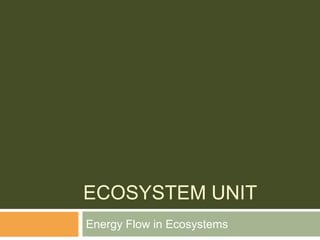
Ecosystem Unit
- 1. Ecosystem Unit Energy Flow in Ecosystems
- 2. What if??? All the plants and animals disappeared?
- 3. Lets Think About This… Are all parts of a forest where organisms live the same? If so, explain why you think that. If no, explain why you think that. What are some habitats (see p. 7 if you need to learn what a habitat is) in a forest? Why do you find different kinds of organisms in different habitats?
- 4. Ecology Study of interactions of living things with one another and their environment
- 5. Habitat An environment that provides the resources, such as food, water, and shelter that an organisms needs to live, grow, and reproduce
- 6. Biotic vs. Abiotic Factors Living Examples Plants Animals Fungi Bacteria Non-Living Examples Water Sunlight Soil Air Temperature
- 7. Biotic vs. Abiotic Factors Identify the biotic vs. abiotic factors in this image below.
- 8. Levels of Organization Organism Population Community Ecosystem Ecosystem Community Population Organism
- 9. Organism Living Thing I’m ALIVE!!!
- 10. Population All members of one species living in the same area Species-similar individuals that can mate to produce fertile offspring Example… humans in Corunna We’re alike… One big happy population!
- 11. Community All the different populations that live and interact together in an area Example: Corunna Community consists of people, cats, dogs, birds, worms, insects, frogs, trees, flowers, grass, etc These are the organisms we see each day…
- 12. Ecosystem The community of organisms that live in a particular area along with their non-living surroundings All the abiotic and biotic factors Examples: Corunna Ecosystem– includes all community members plus pond, lake, fields, air we breath, etc.
- 13. Energy Roles in Ecosystem Producers Consumers Decomposers Do you KNOW your role?
- 14. Producers Make their own food Use energy from the sunlight to turn raw materials into food by the process of photosynthesis Source of all food within an ecosystem Examples: plants, algae, blue-green bacteria
- 15. Consumers Cannot make their own food Feed directly or indirectly on producers for food and energy How does these organisms differ?
- 16. Types of Consumers Herbivores Only eat plants Omnivores Eats both plants & animals Carnivores Only eats animals Scavengers Eat bodies of dead organisms I want to suck your blood!!! Yummy Salads!!! I’ll have a trout with a side of berries Serve up the ROAD KILL!!!
- 17. Decomposers Breaks down waste and dead organisms into simpler substances (decay) Essential to Ecosystem Rid environment of dead bodies Return raw materials to ecosystem for producers to use (recycle) Examples: Mushrooms (fungi) & Bacteria
- 18. Energy Transfers in Ecosystems Movement of energy through an ecosystem can be shown in diagrams Food Chains Food Webs
- 19. Food Chains Series of event in which one organism eats another to obtain energy Shows only one possible path of energy Arrow points in direction that energy flows Decomposers usually left off, but mark the end of the chain What will happen to the other organisms in the food chain if the grass dies?
- 20. Food Web Most organisms eat more than one kind of food, there must be more than one food chain in an ecosystem Consists of many overlapping food chains If an organisms is removed, other organisms probably will not die because there are other food resources Global Food Web- all the world’s food webs interconnected
- 21. Food Web
- 22. Consumers Levels Location of a consumer along a food chain 1st Level- feeds on the producer 2nd Level-feeds on 1st level 3rd level feeds on 2nd level Organisms use energy it obtains to grow, move, reproduce, and carry out activities Rest of energy is lost to environment Each successive (higher) level will have less energy available Fewer organisms at highest level, Since much energy is lost
- 23. Food Web & Consumer Levels 2nd Level Consumer 3rd Level Consumer 1st Level Consumer 2nd Level Consumer Producer
- 24. Energy Pyramid Shows the amount of energy that moves from one feeding level to another in a food web 3rd Level Consumers (1 kcal) Energy decreases as you move up the pyramid… Therefore, fewer organisms 2nd Level Consumers (10 kcal) 1st Level Consumers (100 kcal) Producers (1,000 kcal)
- 25. Energy…What happens to it? Stored in chemical bonds that make up molecules of all living things At each link in food chain, molecules are broken down (digested) and recombined into new molecules Some energy used by organism for basic life functions Much of energy dissipates into environment as heat Flows from sun to producers to consumers to decomposers
- 26. References Cronnin Jones Ph. D, L., & Lisowski, P. M. (2009). Prentice Hall Science Explorer: Environmental Science. Upper Saddle River: Pearson Education, Inc.